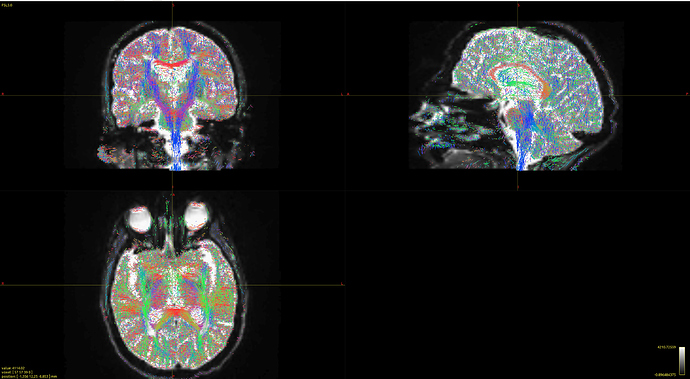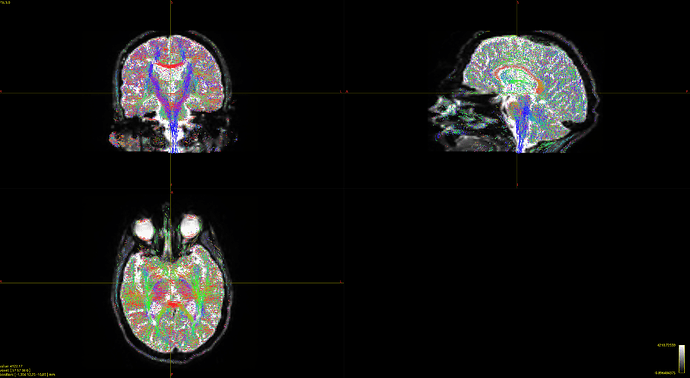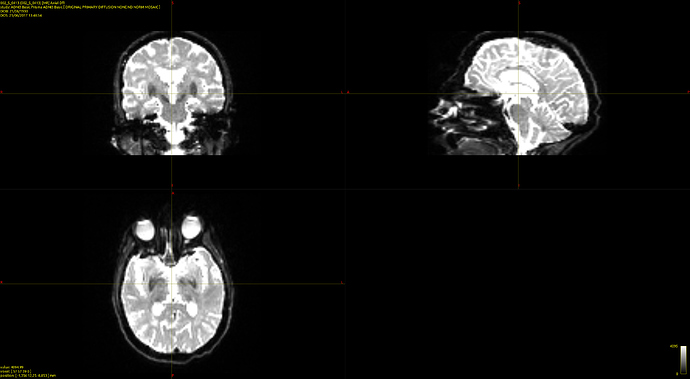I am trying to do a registration of DTIs with mrregister, and I am using as a template the one provided by fsl (data/standard/MNI152_T1_1mm.nii.gz),
Am I interpreting this correctly in that you are attempting to directly register diffusion-weighted images to a T1-weighted template? This won’t work with mrregister: It currently only has a squared-difference metric, which only works for images with highly comparable contrast and intensity ranges. One can either use an alternative software tool that supports more complex image similarity metrics for registration, or if you’re feeling adventurous, you could try this trick.
I also read that is better to register the structural image to the diffusion image, so, should I register fsl’s template to the DTIs I have? Or do I need another image to use as a template?
The primary justification for T1->DWI intra-subject transformation is that corresponding rotation of diffusion gradient directions is not required. THis is less of a concern now since mrtransform will do this automatically if the gradient table is provided / stored in the image header, but it’s a caveat worth being aware of nonetheless. If using some other registration tool, whether T1->DWI or DWI->T1 registration is preferable (including the caveat that one is an individual subject and one is a template image) will depend on the particular operation of that tool; mrregister is fully symmetric and order-agnostic (though the order of the input images to mrregister influences how you must use the data it produces subsequently).
Is the use of the FSL-provided FA template a valid alternative for registration? (Whether or not this question is even relevant will depend on the answer to some questions below)
@jimbo’s response #3 also applies here.
… after the registration I want to do the segmentation of the images …
There’s not enough information in this statement to know exactly what kind of image processing step you’re intending to perform. But if you’re referring to tissue segmentation of an anatomical image, this segmentation is subject-specific and is not performed on a template; see comment further below.
As far as I know mrregister is designed to register FODs so it is not a good option to register different modalities …
While mrregister has the capability to take FOD information into account during registration, it’s not restricted to only FOD-based registration. Its inability to deal with inter-modal registration comes specifically from only possessing the squared-difference metric, as opposed to more complex metrics such as mutual information.
I am doing the question about registration because after that, I should perform segmentation with 5ttgen (which says that the image should be co-registered) and after that I will call tckglobal with the segmented images.
This refers specifically to the fact that if tissue segmentation of an anatomical image is going to be used to select exemplar voxels for response function estimation (i.e. specifically the 5ttgen msmt_5tt algorithm), the anatomical image must be very well aligned with the diffusion image series. However this is an intra-subject registration requirement, and has nothing to do with a template image.
(I use MRtrix for the transformation step because I assume MRtrix rotates the B table during the transformation. Can anyone confirm?)
Correct. You do however need to perform the appropriate conversion via transformconvert, just as you have done in your flirt example, since the coordinate conventions used by different softwares to represent spatial transformations differ.


 I am kind of confuse with all this topics (as shown in my questions). Yes, my goal is to generate a tractography using
I am kind of confuse with all this topics (as shown in my questions). Yes, my goal is to generate a tractography using 








